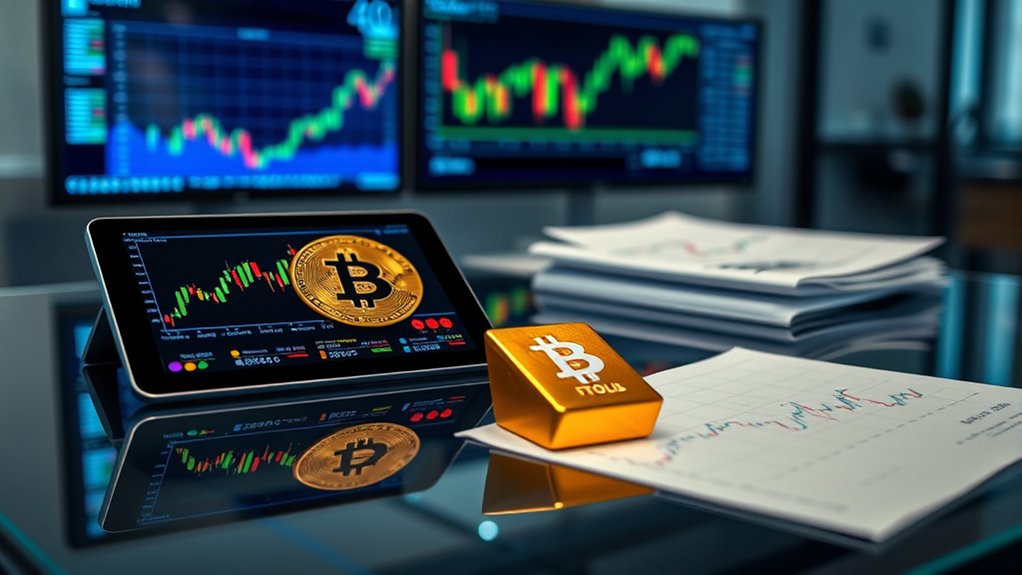Bitcoin’s limited supply and programmed halving events make it a unique potential hedge against inflation, as its scarcity can increase value over time. When inflation rises, Bitcoin often appreciates, especially with growing institutional support. However, its high volatility and regulatory uncertainties can make its role unpredictable. While some see it as digital gold, others find price swings worrisome. To understand how Bitcoin performs as an inflation hedge, you’ll find important insights as you explore further.
Key Takeaways
- Bitcoin’s fixed supply and programmed halving events create scarcity, supporting its role as a potential inflation hedge.
- Historical data shows Bitcoin often appreciates during rising inflation periods, indicating some hedge-like qualities.
- Institutional adoption and regulatory clarity influence Bitcoin’s stability and perception as an inflation protection asset.
- Its high volatility and susceptibility to regulatory shocks challenge Bitcoin’s reliability as a stable inflation hedge.
- Comparative analysis suggests Bitcoin offers portability and transparency advantages over traditional assets like gold and stocks.
Understanding Bitcoin’s Fixed and Deflationary Supply

Bitcoin’s fixed supply of 21 million coins is fundamental to its role as an inflation hedge. Unlike traditional currencies that governments can print endlessly, Bitcoin’s supply is capped by design, making it immune to inflation caused by excessive printing. This scarcity creates a deflationary effect, meaning the value of Bitcoin can increase over time as demand grows. The protocol’s programmed halving events, which cut the number of new Bitcoins issued every four years, reinforce this deflationary nature. You won’t find this predictable supply schedule in most assets, giving Bitcoin a unique advantage. By controlling inflation and maintaining scarcity, Bitcoin positions itself as a digital store of value, appealing to those seeking to protect their wealth from currency devaluation. Additionally, Bitcoin’s blockchain technology ensures transparency and security, further strengthening its appeal as a reliable store of wealth.
Bitcoin’s Price Movements in Response to Inflation Trends

When inflation rises or expectations of inflation increase, Bitcoin’s price often responds with notable appreciation. As investors seek assets that preserve value, Bitcoin’s fixed supply and deflationary design make it attractive during inflationary periods. You’ll notice that during times of rising prices, Bitcoin tends to gain momentum, reflecting its perception as a store of value. Additionally, its decentralized nature supports its appeal as an alternative to traditional currencies. However, its response isn’t always immediate or proportional; market sentiment, macroeconomic factors, and regulatory news also influence its movements. Despite its volatility, Bitcoin generally shows a tendency to appreciate when inflation fears mount, making it a potential hedge. Still, this reaction isn’t guaranteed, and price swings can be sharp. Understanding this dynamic helps you evaluate Bitcoin’s role amid changing inflation trends and economic uncertainties.
The Role of Institutional Investors in Shaping Bitcoin’s Hedge Potential

Institutional investors are increasingly adopting Bitcoin, which influences its market stability and growth prospects. Their strategies and sentiment can substantially affect Bitcoin’s price and perception as an inflation hedge. Regulatory changes also play a vital role, shaping how institutions participate and impact the overall market dynamics. For example, recognizing toxic relationships can help investors identify potential risks associated with market manipulation or undue influence that might affect Bitcoin’s stability.
Institutional Adoption Trends
As institutional investors increasingly embrace cryptocurrencies, their involvement substantially influences Bitcoin’s potential as an inflation hedge. Their growing adoption signals confidence in Bitcoin’s unique qualities—fixed supply, transparency, and decentralization—that appeal during inflationary times. You can imagine large firms allocating significant assets, diversifying portfolios, and signaling stability despite market volatility. Think of:
- Major financial institutions adding Bitcoin to hedge against inflation risks.
- Pension funds and asset managers integrating Bitcoin for diversification.
- Corporate treasuries holding Bitcoin as a reserve asset amid economic uncertainty.
- The beneficial role of eye patches in supporting overall eye health and appearance, which, while unrelated to finance, underscores the importance of maintenance and proactive care in various aspects of life.
This trend boosts Bitcoin’s legitimacy and market stability, encouraging further adoption. As more institutions participate, demand increases, which can impact Bitcoin’s price and perception as an inflation hedge—shaping its role in the broader financial ecosystem.
Impact on Market Dynamics
The involvement of institutional investors considerably influences Bitcoin’s market dynamics and its effectiveness as an inflation hedge. Their large trades can cause significant price swings, increasing volatility. Institutional buying often signals confidence, boosting market perception and attracting retail investors. Conversely, large sell-offs can lead to sharp declines, undermining stability. Their strategies also impact liquidity, sometimes stabilizing prices, other times amplifying fluctuations. The following table highlights key aspects:
| Aspect | Impact |
|---|---|
| Adoption | Drives demand and legitimizes Bitcoin |
| Market Moves | Large trades affect short-term prices |
| Sentiment | Influences investor confidence |
| Liquidity | Affects stability during transactions |
| Volatility | Can increase due to institutional activity |
Furthermore, the exfoliating properties of glycolic acid can improve skin texture, indirectly supporting overall skin health and appearance.
Regulatory Influences
Regulatory changes play a crucial role in shaping Bitcoin’s effectiveness as an inflation hedge by influencing how institutions participate in the market. When regulations become clearer, institutional investors gain confidence, increasing their holdings and stabilizing the market. Conversely, uncertain or restrictive rules can cause hesitation, reducing market liquidity and affecting Bitcoin’s price stability. You can imagine:
- Tightened regulations causing institutional hesitancy, like a dam holding back inflows.
- Clearer rules acting as a green light, encouraging large-scale investments.
- Regulatory crackdowns triggering sudden sell-offs, resembling a storm disrupting calm waters.
These shifts directly impact Bitcoin’s perception as a reliable hedge. As regulation evolves, it influences adoption, market stability, and ultimately, Bitcoin’s role in inflation protection strategies. Additionally, projector technology advancements can influence investor perceptions of digital assets by improving transparency and security measures.
Economic Conditions and Bitcoin’s Resilience During Crises

Economic conditions often test Bitcoin’s resilience, especially during times of crisis when traditional assets falter. When markets become volatile or face upheaval, Bitcoin’s decentralized nature and limited supply can make it an attractive alternative. During the COVID-19 pandemic, Bitcoin showed its ability to withstand severe economic shocks, outperforming many conventional assets. Its independence from government policies and monetary systems helps it avoid direct impact from inflationary pressures and policy uncertainty. However, market turbulence can also trigger sharp price swings, challenging its stability as a safe haven. Still, many investors see Bitcoin as a resilient store of value during economic downturns, especially when traditional assets decline or lose confidence. Its capacity to adapt under stress underscores its potential role amid broader economic uncertainties.
Comparing Bitcoin With Traditional Assets Like Gold and Stocks

When comparing Bitcoin with traditional assets like gold and stocks, it’s clear that Bitcoin offers unique advantages rooted in its digital, decentralized nature. Unlike gold, which requires physical storage and can be difficult to transport, Bitcoin is portable and easy to transfer globally with minimal costs. Its fixed supply and transparent issuance schedule set it apart from stocks, which are influenced by company performance and market sentiment. Visualize:
- A digital coin secured by blockchain, accessible anywhere, anytime
- Gold stored in vaults, requiring physical security and insurance
- Stocks fluctuating based on corporate earnings and economic news
Bitcoin’s potential for appreciation during inflation, combined with its decentralized design, makes it a compelling alternative to traditional assets. However, its high volatility remains a critical factor to weigh.
Challenges and Risks Impacting Bitcoin’s Effectiveness as an Inflation Hedge

You should be aware that Bitcoin’s high market volatility can make it unpredictable, challenging its role as a stable inflation hedge. Regulatory uncertainties also pose risks, as sudden changes in laws or restrictions could impact its adoption and value. These factors can hinder Bitcoin’s reliability when you’re counting on it to protect your assets from inflation.
Market Volatility Risks
Despite Bitcoin’s potential as an inflation hedge, its high market volatility poses a significant challenge. Price swings can be dramatic, making it difficult to rely on as a stable store of value during uncertain economic times. You might see Bitcoin’s value skyrocket one day and plummet the next, adding unpredictability to your investment. This volatility can cause hesitation among investors who seek stability. Visualize the sharp spikes and sudden drops that resemble a roller coaster ride, rather than a steady growth trajectory.
- Sudden price swings that resemble lightning strikes in a storm.
- Rapid shifts in value that feel like riding a wild wave.
- Frequent market swings that resemble a heartbeat, unpredictable and intense.
- Automation’s role in business intelligence enhances the speed and accuracy of data analysis, helping investors better understand market trends and reduce uncertainty.
Regulatory Uncertainty Effects
Regulatory uncertainty poses a significant challenge to Bitcoin’s role as an inflation hedge because changing policies can quickly alter its market environment. When governments introduce new rules or crack down on cryptocurrency trading, it can cause sharp price swings and undermine confidence. These regulatory shifts often add unpredictability, making it harder for investors to rely on Bitcoin as a stable store of value. Additionally, unclear or inconsistent regulations across countries can fragment the market, limiting Bitcoin’s global usability. You might find yourself hesitant to hold or use Bitcoin if you fear future restrictions or bans. This uncertainty can also slow mainstream adoption, reducing Bitcoin’s effectiveness as a hedge against inflation. Furthermore, Personality Traits such as impulsiveness or risk aversion can influence investor reactions to regulatory news, amplifying market volatility. Until regulations become clearer and more stable, this ongoing unpredictability remains a significant risk.
Frequently Asked Questions
How Does Bitcoin’s Fixed Supply Affect Its Long-Term Inflation Hedge Potential?
Your understanding is correct: Bitcoin’s fixed supply of 21 million coins strengthens its potential as a long-term inflation hedge. Since no new coins are created beyond this cap, it’s resistant to inflationary pressures from increased money supply. As inflation rises, Bitcoin’s scarcity can drive its value higher, making it a compelling store of value over time. However, market volatility still influences its effectiveness as a hedge.
What Are the Main Factors Causing Bitcoin’s Market Volatility?
You see Bitcoin’s market volatility mainly driven by factors like market sentiment, regulatory changes, and macroeconomic events. When investors react to news or policy shifts, prices swing rapidly. Additionally, institutional moves and speculative trading amplify fluctuations. You should also consider scalability issues and security concerns, which can shake confidence. All these elements combine to make Bitcoin’s price highly unpredictable in the short term, even if it has long-term potential.
How Do Regulatory Changes Influence Bitcoin’s Effectiveness as an Inflation Hedge?
Regulatory changes can substantially impact Bitcoin’s effectiveness as an inflation hedge. When regulations become stricter, they may limit access or increase compliance costs, causing price volatility and reducing confidence. Conversely, clear and supportive regulations can foster adoption, stabilize markets, and enhance its role as a hedge. You should stay informed on policy shifts because they influence investor sentiment and Bitcoin’s long-term resilience against inflation.
Can Bitcoin’s Price Stability Be Relied Upon During Economic Crises?
You can’t fully rely on Bitcoin’s price stability during economic crises. While it has shown resilience and potential as a hedge, its high volatility and market shifts make its value unpredictable. During times of financial turmoil, Bitcoin can experience sharp fluctuations, which might undermine its stability as a safe haven. So, if you’re depending on it for stability, be prepared for possible swings and consider diversifying your assets.
How Does Bitcoin Compare to Gold in Terms of Safe-Haven Qualities?
Bitcoin doesn’t showcase the same safe-haven qualities as gold because it’s more volatile and influenced by market sentiment. While gold has a long history of stability during economic turmoil, Bitcoin’s price can swing wildly, making it riskier in crises. However, Bitcoin’s decentralization and digital nature provide unique benefits. If you’re seeking safety during instability, gold remains a more reliable option, but Bitcoin offers growth potential outside traditional financial systems.
Conclusion
While Bitcoin shows promise as an inflation hedge, its true resilience remains uncertain. Its unique supply mechanics and growing institutional interest suggest potential, but risks and market volatility linger. As economic conditions evolve, the question lingers: can Bitcoin truly withstand the tides of inflation, or will unforeseen challenges reshape its role? The answer isn’t clear yet, and the coming years might hold surprises that will redefine what you thought you knew about Bitcoin’s hedge potential.








